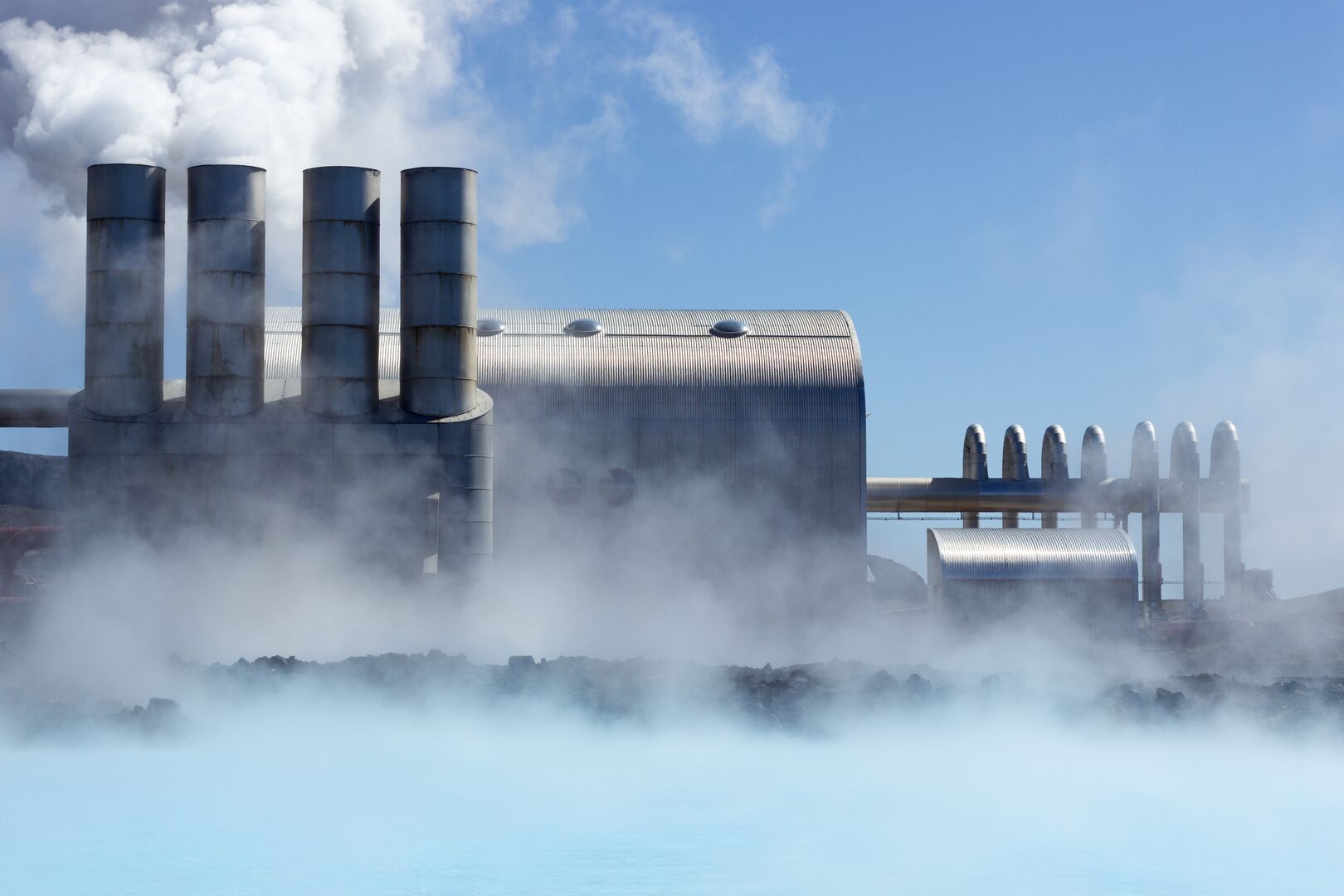First used in Italy in 1904, geothermal has been a consistent – and expanding – source of energy in recent years. According to the International Renewable Energy Agency (IRENA), geothermal energy has grown steadily from around 10GW worldwide in 2010 to circa 15GW in 2020. Projections to 2030 show this installed capacity nearly doubling. So, what is geothermal energy, how does it work and why does it matter to us?

1. What is geothermal energy and how is it used?
Geothermal energy is the heat that comes from the sub-surface of the earth. It is contained in the rocks and fluids beneath the earth’s crust and can be found as far down, or shallow, as the earth’s hot molten rock, magma. To produce power from geothermal energy, wells are drilled a mile deep (on average) into underground reservoirs to access steam and hot water, which can then be used to drive turbines connected to electricity generators to create a power and heat source.
In Europe for example, geothermal energy is used in central heating solutions, for people’s homes in France or Germany. It is also used in the Netherlands to heat giant greenhouses (think tulips and tomatoes exported all over Europe), designed to offset the use of imported natural gas from Russia. In other applications around the world, depending on the temperature of the water or steam from the well it can be used for renewable power generation.
In order to generate power, geothermal fluids can be used directly in steam turbines where the produced fluid is in the state of superheated steam, that can be sent directly to the turbine or it is a liquid at high pressure and temperature that is sent to the turbine after being vaporized.
However, where temperatures of the fluids are lower preventing the use of a steam turbine, an Organic Rankine Cycle (ORC) can be used for power generation. Because superheated steam is not as common to find and lower-temperature geothermal resources are, ORCs are able to be used in many more locations around the world for geothermal power generation. In this case, the geothermal fluid is exploited in a binary cycle, transferring its heat to the working fluid (typically a light hydrocarbon) that is then expanded in a turboexpander to generate electricity. The geothermal fluid is then reinjected into the ground, having no contact with atmosphere, for a zero-leakage solution.
The distinct advantage over other renewable sources of energy is that it’s always on. It doesn’t matter if it’s cloudy or if the wind isn’t blowing. Once it’s online, it stays online. And as a clean emission-free source of energy, it can be utilized for any application that needs electricity.
2. These applications of geothermal energy are not new: why is there renewed interest now?
A combination of factors has contributed to the recent uptake in geothermal energy.
Looking at it from the world’s perspective, a lot of the renewed interest in geothermal energy started from the Paris Climate Agreement in 2015, where many countries committed to undertake initiatives toward carbon reduction, increased use of renewable energy, and emission reduction by 2050.
This has meant increased funding from governments to support initiatives like the development of geothermal energy production, directly impacting new projects and technology development.
From there, the oil and gas industry, the incumbent experts at drilling such wells, pumping, and transporting ‘a fuel source’, has worked on helping de-risk projects and ultimately make geothermal a lot more economic and less risky.
The single biggest challenge for the lifetime of geothermal applications is the prohibitive large upfront capital costs. For a geothermal project to go ahead, the operator is in fact paying for 30 years of energy at the start. The rest of the operating costs are relatively minimal, compared to the energy output. With this renewed interest since the Paris Climate agreement, a lot of new technology has been developed, which has led to a reduction of costs.
Therefore, a mixture of government initiatives, societal support for green energy, and advanced technology first developed by oilfield services companies for shale exploration then adapted for geothermal, have helped ease some of these high upfront costs, making it a viable energy source with the possibility to replace fossil fuel usage at a local level. However, the barrier to entry due to heavy investment is still very high.
It is important to note that there are a tremendous amount of complementary technology and skills that are being transferred from oil and gas into geothermal. Though not new, geothermal has been in ‘competition’ with hydrocarbons, in a context akin to a sibling rivalry, as commodity prices have fluctuated in the last 20 years. Since the Paris agreement – and given the need for more sustainable local energy security/self-dependency – governments in Europe are now actively promoting the development of geothermal projects.
In other regions, such as ‘the ring of fire’ in Asia Pacific, or Africa for example, where emerging economies may still be using animal dung or wood for heating, geothermal energy is providing an expensive yet competitive 24/7 solution. It can compete with hydrocarbons in this instance, as the local oil and gas infrastructure is often non-existent or underdeveloped in the region.

3. Are there other factors that may lower barriers to the adoption of geothermal power?
Geology differs from resource to resource, sometimes meaning a well may be drilled with lower than anticipated flow or production rate, needed to meet a project’s economics.
In this article, we focus on traditional geothermal energy: where a well is drilled, with enough pressure and enough water in the reservoir for the fluid to be produced. It’s either in the form of liquid or steam or liquid that wants to become steam and we keep it under pressure to keep it in a single phase, sometimes for lower-enthalpy or lower temperature systems. If the pressure and temperature are high enough, like in APAC, it makes more sense to just produce the very hot steam and use it as-is. Europe is an example of where we might get temperatures that are above boiling and keep it in a single phase. If there is a pre-existing well-bore, the project’s costs will be greatly reduced and become economically viable.
Geothermal well construction costs can represent 40 to 50% of the total project cost, drilling being the main part of it.
Therefore, operators are looking for solutions to drill faster, increase ROP (rate of penetration), and minimize the risk of a dry hole. In Europe, some governments are insuring operators against drilling a dry hole, encouraging in turn exploration to fuel geothermal growth.
4. How are geothermal power plants moving from naturally volcanic places to other places and what does this mean for future development opportunities?
The traditional geothermal activity and marketplace for development has been around the ‘ring of fire’: namely the entire coastal area of the Pacific Ocean, in Asia and extending from the coast of California, down to Chile; areas that are synonymous with volcanic activity.
In addition to conventional projects in naturally volcanic places, there are exciting new forms of geothermal, given renewed interest thanks to changes in technology and project economics. One is enhanced geothermal systems (EGS) and advanced geothermal systems (AGS).
Growth in the market will come from both conventional, but also EGS, AGS, downhole heat exchangers…etc. However, as of today, projects in the EGS/AGS space are more experimental than profitable. However, market and technology projections put EGS and AGS as 40% of new projects by 2050.
The European market is so fascinating and dynamic as an example. There may be no volcanoes in the Netherlands, yet the growth rate for geothermal heat generation is nearly exponential based on the publicly available master plan for geothermal created by the Dutch government for the next ten years; by utilizing low-temperature geothermal systems-- applications that are between 90 and 110 degrees Celsius. This renewable emission-free heat is used to power greenhouses, and starting to appear in places like Germany, Switzerland, France, and Denmark, as drilling such wells is now becoming cost comparative.

5. Can oil and gas industry skills and technology transfer to geothermal energy and geothermal drilling?
Energy technology companies such as Baker Hughes, which are specialized in hydrocarbon exploration, transportation, and processing are in a unique position to lead the ‘great exploration into geothermal’. Technology and expertise, together with active engagement with professional bodies such as SPE, Geothermal Rising, and the International Geothermal Association are playing a key part.
The deployment of skills from oil and gas into geothermal is very applicable, covering similar domain expertise such as geology and mechanical engineering for example, together with data science. How to best utilize industry talent for this opportunity is being considered, as priorities are changing.
Geothermal presents very similar challenges to oil and gas applications, with a different set of parameters. For example, while the commodity is water instead of oil, the water is very hot and under pressure too; safety considerations come naturally to the oil and gas industry where is HSE is the #1 priority; corrosion mitigation and management is also a key component of manufacturing, maintenance and material science of hydrocarbon equipment today, and relevant to geothermal.
In order to make geothermal well drilling campaigns more cost-effective in the longer run, the ‘factory’ wells approach will need to be adopted as the market develops, similar to the lessons learned from shale exploration in the last 10 years. Oilfield service companies with a global reach are currently able to support and compete in the geothermal market expansion for certain applications in the Americas and Asia for example, while other smaller drilling contractors may offer a niche service for low temperature/larger bore wells in Europe, Turkey…etc.
Baker Hughes, as an energy technology company, brings a unique value proposition to the geothermal market with an expansive portfolio, enabling access to technology and expertise in oilfield services combined together with rotating equipment and digital solutions. Our breadth of applications from reservoir subsurface and feasibility analysis, to geothermal well construction, through to the deployment of turbine technology for geothermal power generation (for heat and electricity), means that direct connections are made between the reservoir simulation and the turbine construction – this results in shorter turbine lead times and project cost reduction from the total optimization of the well and turbine design. The geothermal energy market is dynamic and evolving constantly, and Baker Hughes is competing and innovating in this space.
Energy Forward Stories
Sign up to stay up to date on the latest innovations and people shaping the future of our industry.





